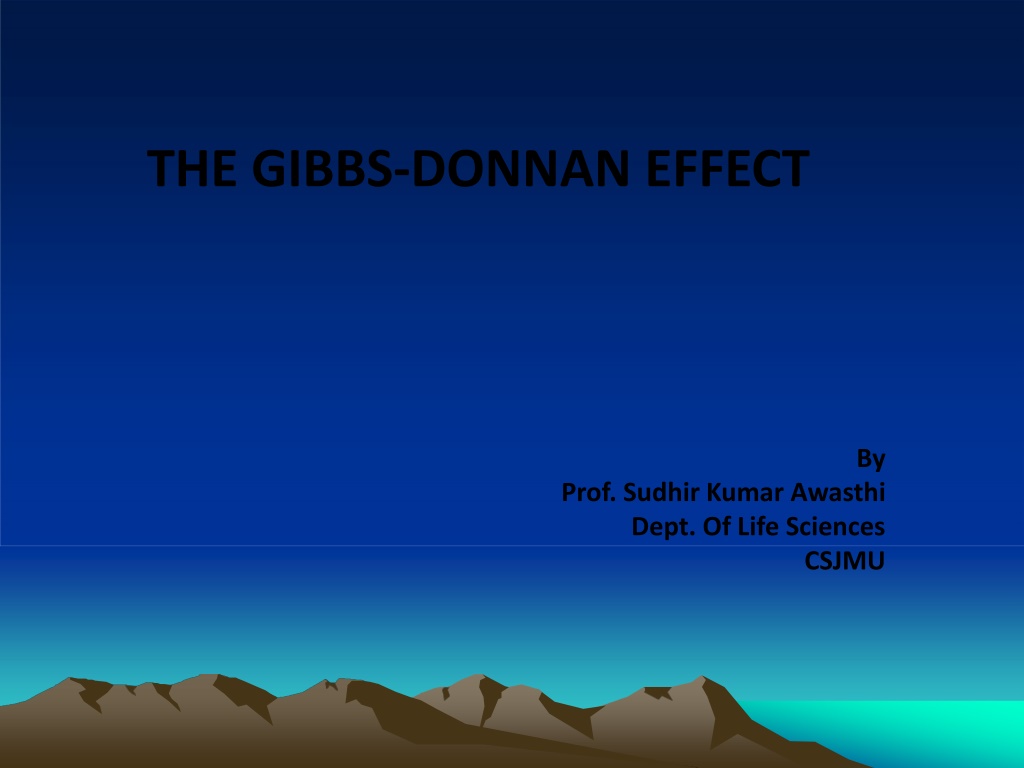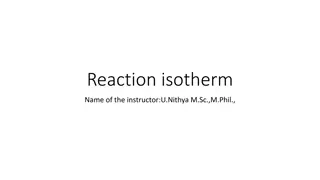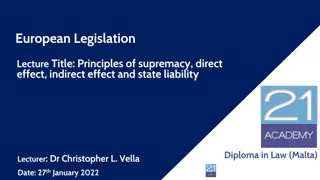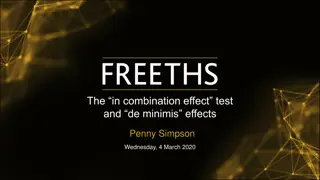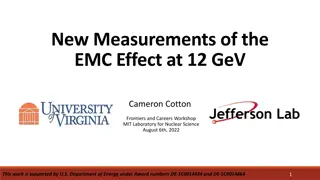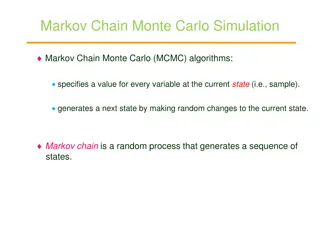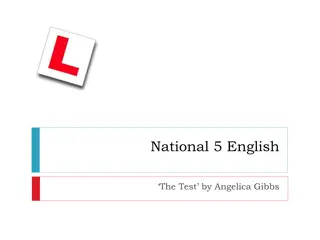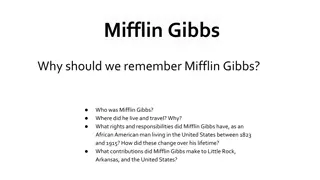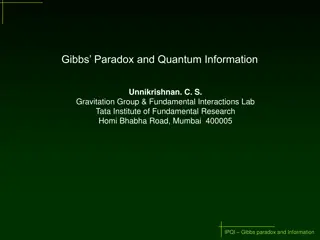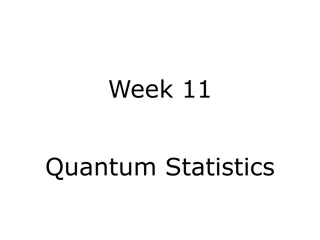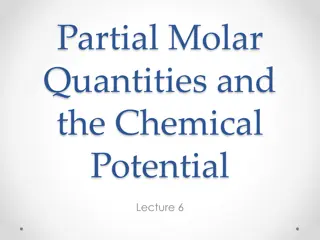Understanding the Gibbs-Donnan Effect in Biological Systems
The Gibbs-Donnan Effect, named after physicists Gibbs and Donnan, explains the selective permeability of membranes to ions, leading to the establishment of Donnan potential. This phenomenon affects the distribution of ions and proteins across cell membranes, influencing processes like osmosis and ion transport. Additionally, facilitated diffusion, a passive transport mechanism involving specific transmembrane channels and carrier proteins, enables the movement of polar molecules and ions across lipid bilayers without requiring energy expenditure.
Download Presentation

Please find below an Image/Link to download the presentation.
The content on the website is provided AS IS for your information and personal use only. It may not be sold, licensed, or shared on other websites without obtaining consent from the author. Download presentation by click this link. If you encounter any issues during the download, it is possible that the publisher has removed the file from their server.
E N D
Presentation Transcript
THE GIBBS-DONNAN EFFECT By Prof. Sudhir Kumar Awasthi Dept. Of Life Sciences CSJMU
Some ionic species can pass through the barrier while others cannot. Solutions may be gels or colloids as well as solutions of electrolytes, and as such the phase boundary between gels, or a gel and a liquid, can also act as a selective barrier. Electric potential arising between two such solutions is called the Donnan potential. Effect named after the American physicist Josiah Willard Gibbs and the British chemist Frederick G. Donnan. Donnan effect is extra attributable to cations (Na+ dissolved plasma proteins. osmotic and K+) attached to pressure
Presence of a charged impermeant ion (for example, a protein) on one side of a membrane will result in an asymmetric permeant charged ions. Gibbs Donnan equation at equilibrium (assuming permeant ions are Na+ and Cl-): [NaSide 1] [ClSide 1] = [NaSide 2] [ClSide 2] distribution of states Start Equilibrium Side 1: 9 Na, 9 Cl Side 2: 9 Na, 9 Protein Side 1: 6 Na, 6 Cl Side 2: 12 Na, 3 Cl, 9 Protein
FacilitatedDiffusion Also known as facilitated transport or passive- mediated transport. It is the spontaneous passage of molecules or ions across a biological membrane passing through specific transmembrane opposed to active transport). May occur either across biological membranes or through aqueous compartments of an organism. Polar molecules and charged ions are dissolved in water but they cannot diffuse freely across the plasma membrane due to the hydrophobic nature of the fatty acid tails of phospholipids that make up the lipid bilayers. integral proteins (as
Only as membrane. All across transmembrane channels. These channels are gated so they can open and close, thus regulating the flow of ions or small polar molecules. Larger molecules transmembrane carrier as permeases that change their conformation as the molecules are carried through, for example glucose or amino acids. small nonpolar can molecules, easily such the oxygen diffuse across polar membranes molecules are transported that by proteins form are transported proteins, by such
Non-polar molecules, such as retinol or lipids are poorly soluble in water. They are transported compartments of cells or space by water-soluble carriers as retinol binding protein. Metabolites are not changed because no energy is required for facilitated diffusion. Only permease changes its shape in order to transport the metabolites. Form of transport through cell membrane which modifies its metabolites is the group translocation transportation. through through extracellular aqueous
Glucose, sodium ions and chloride ions are some examples of molecules and ions that must efficiently get across the plasma membrane but to which the lipid bilayer of the membrane is virtually impermeable. Various attempts have been made by engineers to mimic the process of facilitated transport in synthetic (i.e., non-biological) membranes for use in industrial-scale gas and liquid separations, but these have met with limited success to date, most often for reasons related to poor carrier stability and/or loss of carrier from the membrane.
Kinetics ofDiffusion Fick's first law relates diffusive flux to the concentration under steady state conditions. It postulates that the flux goes from regions of high concentration concentration, with a proportional to the concentration gradient (spatial derivative). In one (spatial) dimension, the law is: J = - D to regions magnitude of that low is x
Where: J is the "diffusion flux" [(amount of substance) per unit area per unit time], measures the amount of substance that will flow through a small area during a small interval. D is the diffusion coefficient or diffusivity in dimensions of [length2time 1] orm2/s. (phi) (for ideal mixtures) is the concentration in dimensions of [amount of substance per unit volume] or mol/m3 x is the position [length] or m example . J time
D is proportional to the squared velocity of the diffusing particles, which temperature, viscosity of the fluid and the size of the particles according to the Stokes-Einstein relation. In dilute aqueous coefficients of most ions are similar and have values that at room temperature are in the range of 0.6x10 9 to 2x10 9 molecules the diffusion coefficients range from 10 11 to 10 10m2/s. depends on the solutions the diffusion m2/s. For biological normally
In two or more dimensions we must use , the del or gradient operator, which generalises the derivative, obtaining J = - D The driving force for the one-dimensional diffusion is the quantity - x which for ideal mixtures is the concentration gradient. In chemical systems other than ideal solutions or mixtures, the driving force for diffusion of each species is the gradient of chemical potential of this species. first
Then Fick's first law (one-dimensional case) can be written as: Ji = Dci i RT x where the index i denotes the ith species, c is the concentration (mol/m3), R is the universal gas constant (J/(K mol)), T is the absolute temperature (K), and is the chemical potential (J/mol).
predicts how diffusion Fick's causes the concentration to change with time: (delta) second law = D 2 t x where is the concentration in dimensions of [(amount of substance) length 3], example mole/m3 t is time [s] D is the diffusion coefficient in dimensions of [length2time 1], example m2/s x is the position [length], example m
Electrochemicalgradient A gradient of electrochemical potential, usually for an ion that can move across a membrane. Gradient consist of two parts: First, an electrical component caused by a charge difference across the lipid membrane. Second, a chemical component caused by a difference in the chemical concentration across a membrane. A combination of these two factors determines the thermodynamically favourable direction for an ion's movement across a membrane.
Difference of electrochemical potentials can be interpreted as a type of potential available for work in a cell. An electrochemical gradient is analogous to the water pressure across a hydroelectric dam. Membrane transport sodium-potassium pump within the membrane are equivalent to turbines that convert the water's potential energy to other forms of physical or chemical energy and the ions that pass through the membrane are equivalent to water that ends up at the bottom of the dam. energy proteins such as the
Also, energy can be used to pump water up into the lake above the dam. In similar manner, chemical energy in cells can be used to create electrochemical gradients. Einstein has shown that the relation between molecular movement and diffusion in a liquid may be expressed by the following equation, when the particles move independently of each other. D = 2/ 2t . 1 D being the diffusion coefficient and 2 the mean square of the deviation in a given direction in time t .
Further it is assumed that the particles possess the same kinetic energy as gas molecules at the same temperature, the following equation holds 2= 2RT . t ..2 N C where R is the universal gas constant, N is the Avagadro number, T is the absolute temperature and C is a constant which is called the frictional resistance of the molecule. Hence, D = RT . 1 . 3 N C
Equations 2 and dissolved molecules and particles of greater dimensions. For spherical molecules moving in a medium of proportionately small molecules Stokes has shown that a hydrodynamic equation namely, C = 6 Zr where r is the radius of a diffusing particle and Z is the viscocity of the diffusion medium. By substituting in (3) we obtain for D the following relation. 3 hold equally good for holds
D = RT . 1 N 6 Zr This is known as the Stokes-Einstein equation and is valid only when the aforesaid conditions are fulfilled.
Osmosis Net movement of solvent molecules through a partially permeable membrane into a region of higher solute concentration, in order to equalize the solute concentrations on the two sides. or A physical process in which any solvent moves, without input of energy, across a semipermeable membrane (permeable to the solvent, but not the solute) separating two solutions of different concentrations.
Net movement of solvent is from the less concentrated (hypotonic) concentrated (hypertonic) solution, which tends to reduce the difference in concentrations. This effect can be countered by increasing the pressure of the hypertonic solution, with respect to the hypotonic. Osmotic pressure is defined as the pressure required to maintain an equilibrium, with no net movement of solvent. Osmotic pressure is meaning that the osmotic pressure depends on the molar concentration of the solute but not on its identity. to the more a colligative property,
Osmosis is essential in biological systems, biological membranes are semipermeable. In general, cell membranes are impermeable to large and polar molecules, such proteins, and polysaccharides, while permeable to hydrophobic molecules like lipids as well as to small molecules like oxygen, carbon nitrogen, nitric oxide, etc. Permeability depends on solubility, charge, or chemistry, as well as solute size. as as ions, being and/or non-polar dioxide,
Water molecules travel through the plasma membrane, tonoplast membrane (vacuole) or protoplast by diffusing across the phospholipid bilayer via aquaporins (small transmembrane proteins similar to those in facilitated diffusion and in creating ion channels). Osmosis provides the primary means by which water is transported into and out of cells. pressure The turgor maintained membrane, between the cell interior relatively hypotonic environment. of a cell is largely the and its by osmosis, across cell
REFERENCES Donnan membrane Principle ; Opportunities for sustainable engineered processes & materials by S. Sarkar, A.K. Singh Gupta (2016) Biochemistry by Lubert Stryer (2015) Biochemistry by Voet & Voet (2015)
